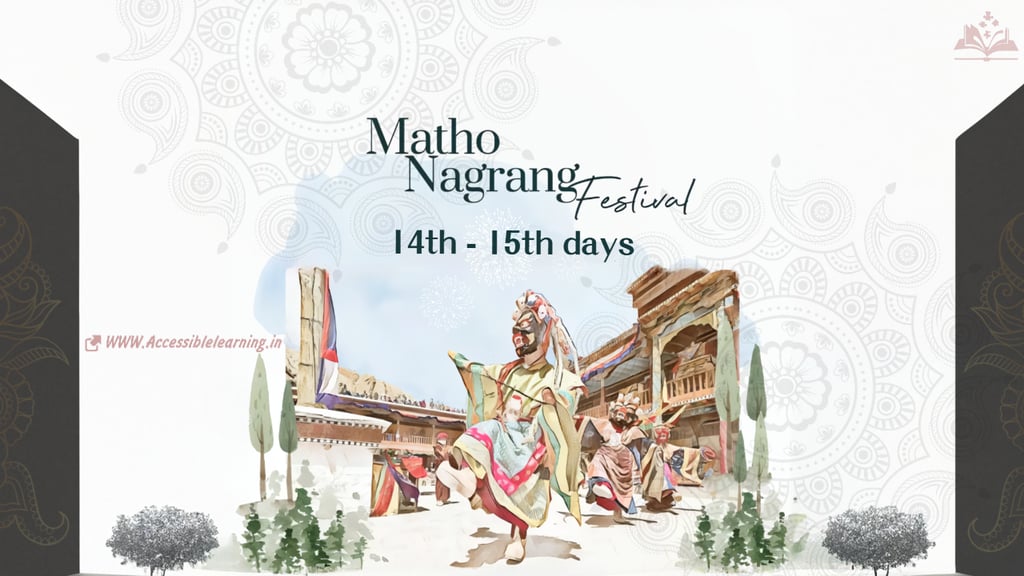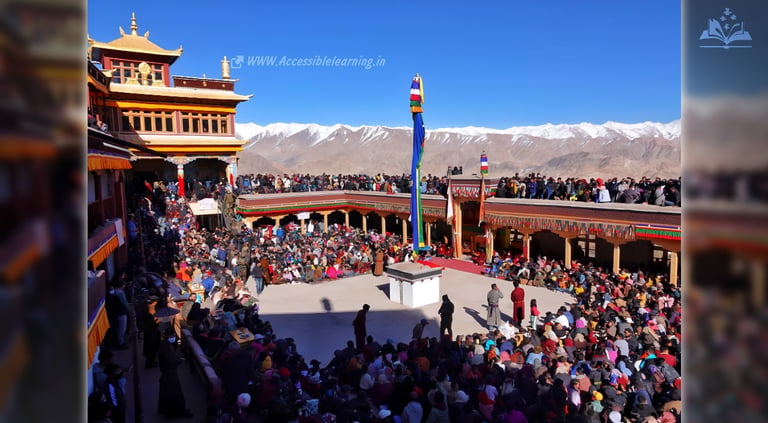
Matho Nagrang Festival: Where Faith Meets Culture in the Himalayas
The enchanting Matho Nagrang Festival of Ladakh, a vibrant celebration of spirituality, culture, and tradition. Learn about its origins, sacred rituals, mask dances, divine oracles, and the breathtaking cultural heritage it showcases
TRAVEL LIFEEVENT/SPECIALEDUCATION/KNOWLEDGEINDIA/BHARATCELEBRATION/FESTIVALS
Sachin K Chaurasiya
1/31/20254 min read


The Matho Nagrang Festival is a mesmerizing blend of spirituality, culture, and tradition that showcases the vibrant heritage of Ladakh. Celebrated annually at the Matho Monastery, located 26 kilometers southeast of Leh, this festival attracts devotees, locals, and curious travelers from across the globe. Its unique rituals, ancient roots, and stunning visual appeal make it one of the most significant and extraordinary festivals in Ladakh.
The Origins of Matho Nagrang Festival
Matho Nagrang is celebrated on the 15th day of the first month of the Tibetan calendar, typically falling in February or March. The festival is deeply rooted in the Buddhist traditions of Ladakh and is organized by the monks of the Matho Monastery, which belongs to the Sakya sect of Tibetan Buddhism. Built in the 16th century by Lama Dugpa Dorje, Matho Monastery is renowned for its architectural beauty and spiritual significance.
The festival's primary aim is to honor the divine oracles and invoke their blessings for prosperity, protection, and guidance. The monks prepare for this event through weeks of meditation, fasting, and rituals, which culminate in the festival’s grand celebrations.
Highlights of the Matho Nagrang Festival
The Divine Oracles (Rongtsan)
The most captivating aspect of the Matho Nagrang Festival is the appearance of two oracles, known as Rongtsan. These oracles are chosen from among the monks of the monastery and undergo intense spiritual training, including isolation and meditation, to prepare themselves for their role.
During the festival, the oracles enter a state of trance and perform awe-inspiring feats that defy human capabilities. They deliver prophecies, answer questions about the future, and provide guidance to the villagers. It is believed that they are possessed by deities during this time, granting them extraordinary powers.
Their performances include walking on the monastery's rooftops, balancing on precarious ledges, and even cutting themselves with knives without sustaining injuries. These acts symbolize their divine connection and their role as intermediaries between the spiritual and physical worlds.
Sacred Mask Dances (Chham)
Another highlight of the festival is the vibrant mask dances, or Chham, performed by the monks. These dances are not merely entertainment but have profound spiritual significance. Wearing elaborately crafted masks representing various deities and demons, the monks enact stories from Buddhist mythology. The dances are accompanied by traditional music, featuring cymbals, drums, and horns, creating an otherworldly atmosphere.
The intricate masks and costumes worn by the monks are often handmade, showcasing the region's artistic heritage. The dances are believed to ward off evil spirits and bring blessings to the community.
Traditional Attire and Artifacts
The festival is a visual feast, with participants and attendees dressed in colorful traditional Ladakhi attire. The monks don ceremonial robes and intricate masks, while locals showcase their rich culture through their clothing and jewelry. The monastery is adorned with prayer flags, thangkas (Tibetan Buddhist paintings), and other sacred artifacts, adding to the festival's spiritual ambiance.
Community and Celebration
The Matho Nagrang Festival is a time of joy and togetherness for the Ladakhi community. People from neighboring villages gather at the monastery to participate in the rituals, seek blessings, and celebrate their shared heritage. The festival also serves as a platform for cultural exchange, as visitors from around the world join the festivities.
Local stalls are often set up around the monastery, offering traditional Ladakhi food, handicrafts, and souvenirs. These stalls provide visitors with a chance to experience the region’s culinary and artistic traditions.
Preparation and Rituals
The preparation for the Matho Nagrang Festival begins weeks in advance. Monks engage in rigorous meditation and fasting to purify their minds and bodies. The monastery’s sacred objects are also cleaned and consecrated in preparation for the rituals.
Special prayers and ceremonies are conducted to invoke the protection and guidance of guardian deities. The atmosphere within the monastery becomes charged with spiritual energy as the monks and villagers collectively focus on the festival’s spiritual objectives.


Spiritual Significance
The Matho Nagrang Festival is deeply spiritual, embodying the essence of Buddhist philosophy. The rituals and ceremonies are meant to ward off evil spirits, ensure the well-being of the community, and strengthen the bond between humans and the divine. The festival also emphasizes the importance of self-discipline, meditation, and devotion in achieving spiritual growth.
The presence of the oracles underscores the belief in the interconnectedness of the spiritual and physical worlds. Their prophecies and guidance are seen as a direct link to divine wisdom, reinforcing faith and devotion among the attendees.
Visiting Matho Nagrang Festival
For travelers, the Matho Nagrang Festival offers a rare opportunity to witness an ancient tradition that has remained largely untouched by modernity. To attend the festival, visitors can travel to Leh and then proceed to Matho Monastery, which is easily accessible by road. The winter setting adds to the charm, with snow-capped mountains and serene landscapes providing a stunning backdrop.
It is advisable to dress warmly and respect local customs and traditions while attending the festival. Photography is generally allowed, but visitors should seek permission before capturing religious ceremonies or portraits of the oracles.
Travelers can also explore nearby attractions, such as the Thiksey Monastery, Hemis Monastery, and the picturesque Indus Valley. Combining the festival with visits to these landmarks makes for an unforgettable journey through Ladakh’s cultural and spiritual landscape.
The Matho Nagrang Festival is more than just a celebration; it is a window into the rich cultural and spiritual tapestry of Ladakh. Its vibrant dances, profound rituals, and deep-rooted spirituality make it a unique and unforgettable experience. For anyone seeking to explore the mystical traditions of the Himalayas, this festival is an unmissable event that promises to leave a lasting impression.
By attending the Matho Nagrang Festival, visitors not only witness an extraordinary spectacle but also gain a deeper appreciation for the enduring traditions and beliefs that define Ladakh. It is a celebration of faith, resilience, and community that continues to inspire and captivate all who experience it.
Subscribe To Our Newsletter
All © Copyright reserved by Accessible-Learning Hub
| Terms & Conditions
Knowledge is power. Learn with Us. 📚


